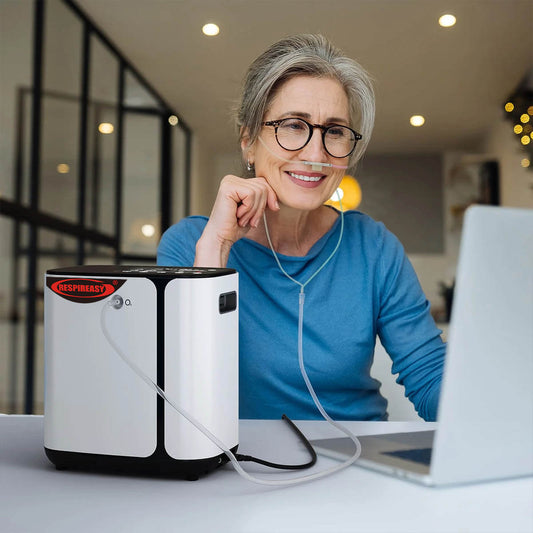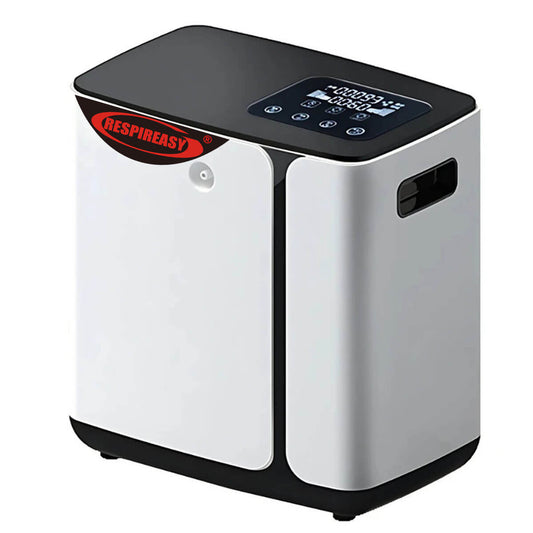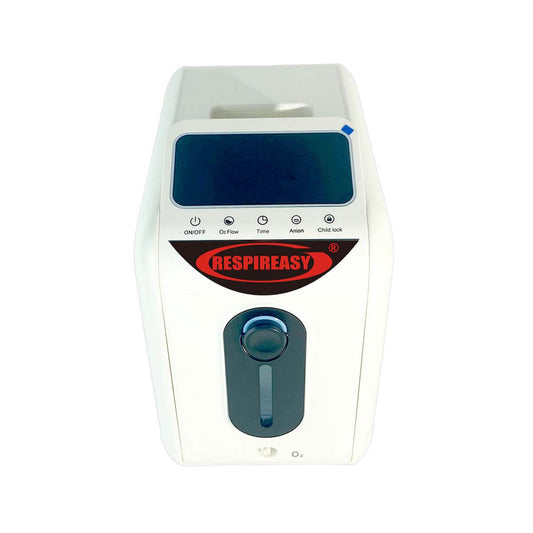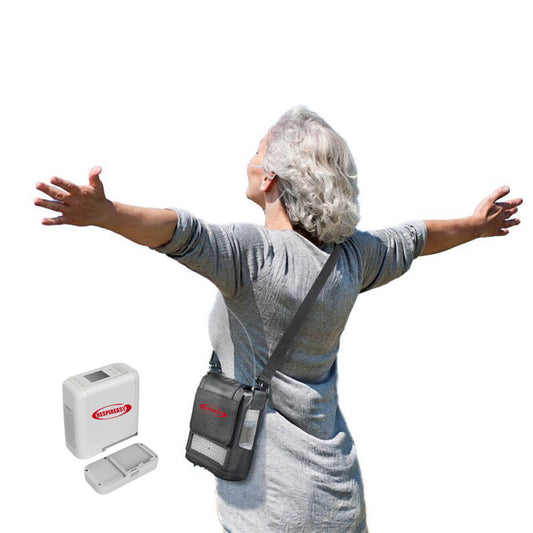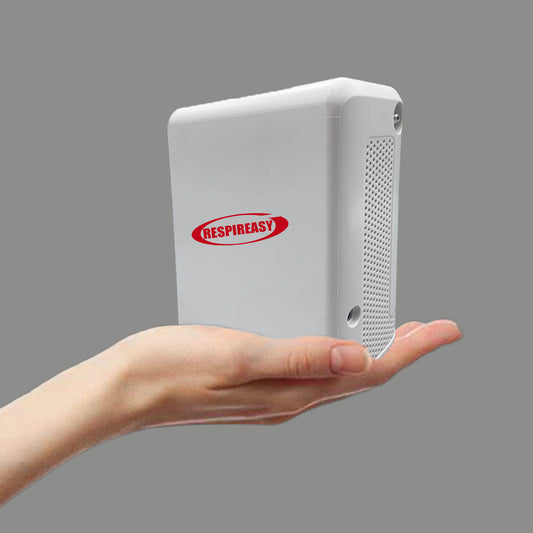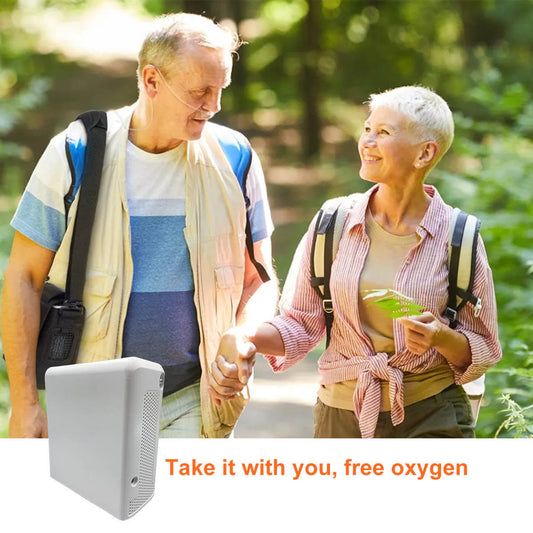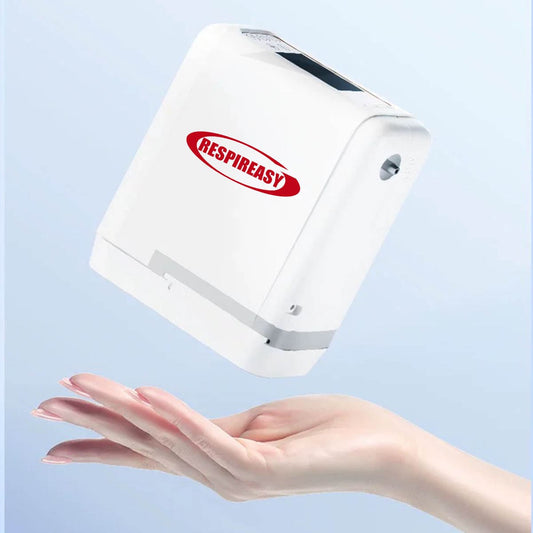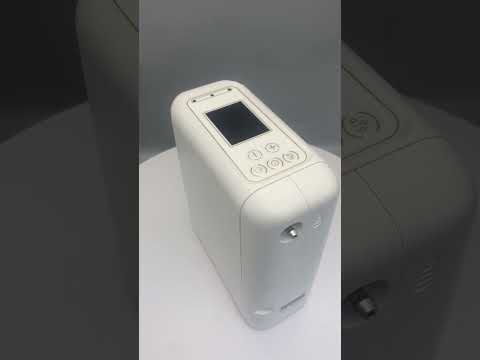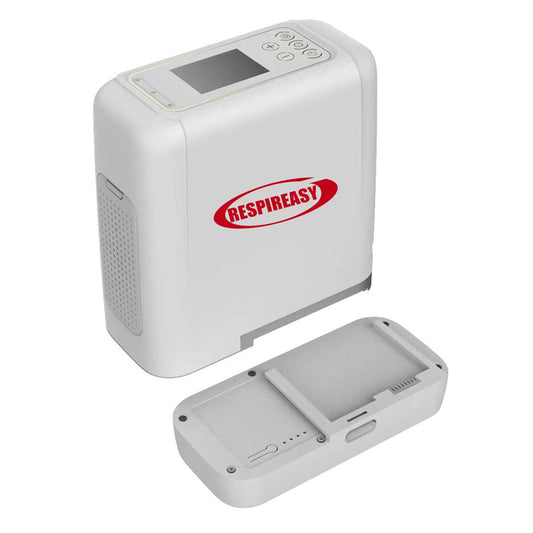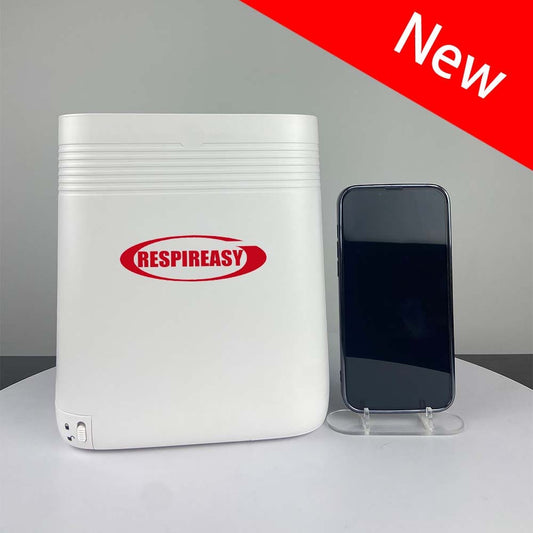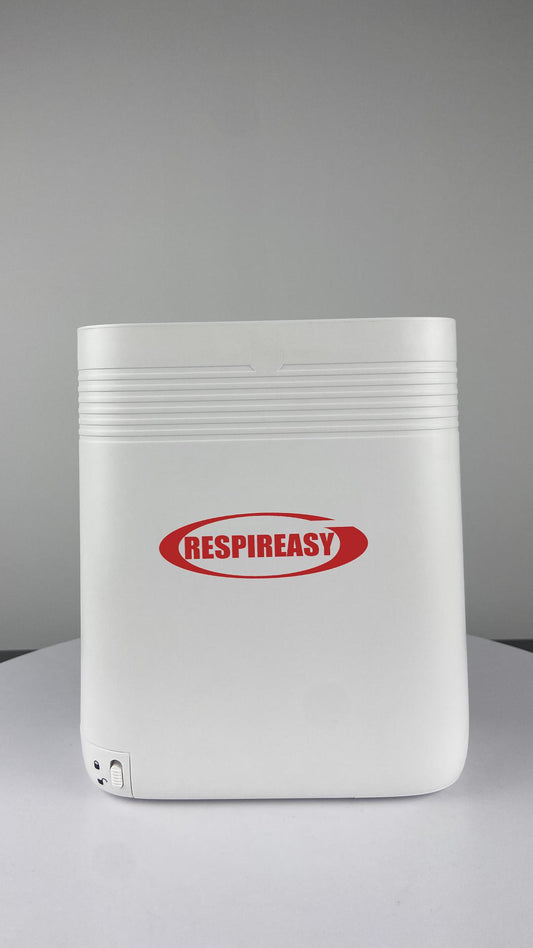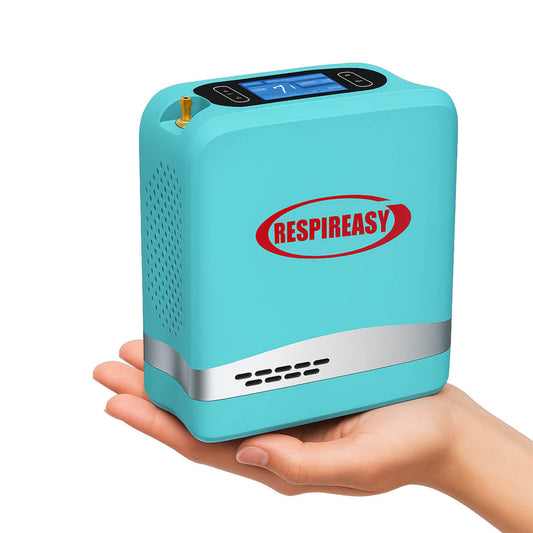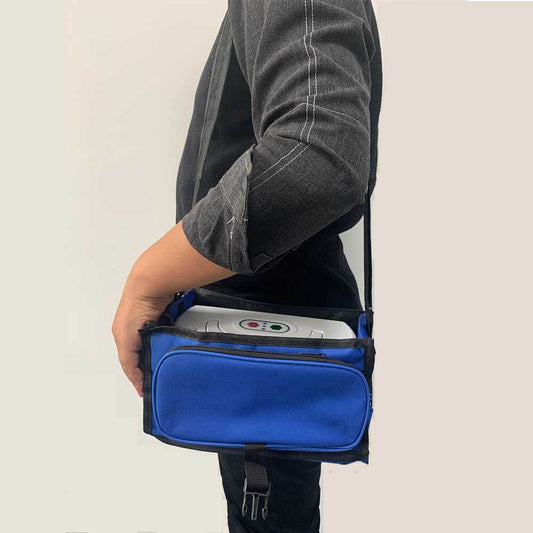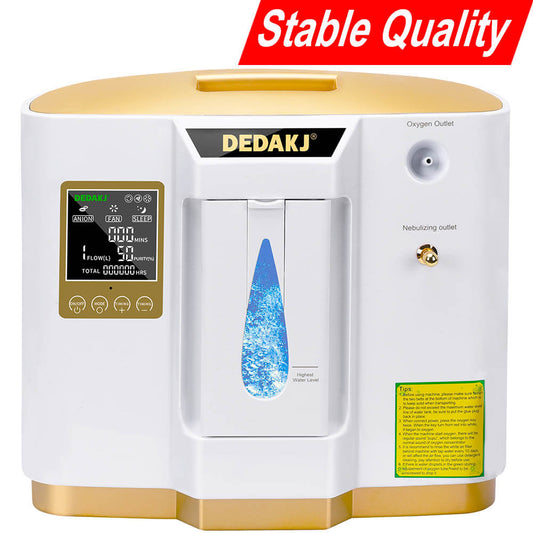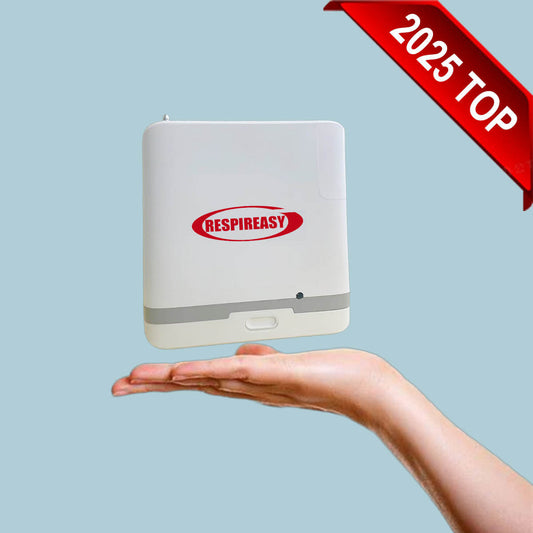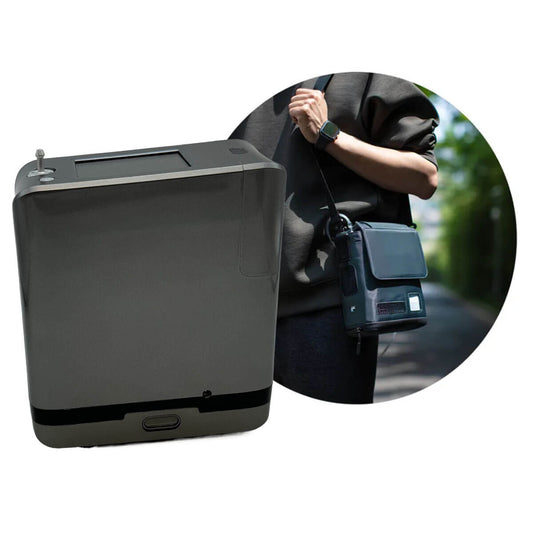Household Oxygen Generator
Household Oxygen Generator
There are many kinds of household oxygen generators on the market. Due to the different principles of oxygen generation, the characteristics of each household oxygen generator are also different.
Oxygen making principles of household oxygen generators are:
1.Molecular sieve principle;
2.Principle of polymer oxygen-enriched membrane;
3.The principle of electrolysis of water;
4.The principle of chemical reaction oxygen production.
The molecular sieve oxygen generator is the only mature oxygen generator with international and national standards.
Name : household oxygen generator
Power mode : DC, AC
Use environment : car, home
Oxygen production methods : physical oxygen production, molecular sieve oxygen production, electronic oxygen production
Technology used : PSA molecular sieve pressure swing adsorption
Applicable environment : home use
Noise level : ≤45DB
The household oxygen concentrator is easy to use, portable and light, and is suitable for the majority of health care workers. The vehicle-mounted dual-purpose type is not only suitable for home use, but also can be used in the car by using the power supply of the car. Oxygen is a colorless and odorless gas. It is an important substance for the survival of the human body and an important substance for the survival of other animals and plants. Without oxygen, nature will be lifeless and lifeless, and its importance is just like water. Oxygen is used in a wide variety of applications, including healthcare and beauty care, among others.

Click here to check more detail about Home Oxygen Cocnentrator:
https://dedakjoxygenconcentrators.com/collections/home-use-oxygen-concentrator
Today's living standards are getting better and better, and everyone knows how to keep in good health. In order to improve the quality of life of work-related injuries caused by pneumoconiosis and other work-related injury workers who have impaired lung function and difficulty breathing and need to inhale oxygen for a long time, we bought an oxygen generator to send To the family, care for their health. Now that the living conditions are better, we should pay more attention to health care, such as buying an oxygen generator at home, so that the whole family can be in good health .
Working Principle
Working principle of household oxygen generator: use molecular sieve physical adsorption and desorption technology. The oxygen concentrator is filled with molecular sieves, which can absorb nitrogen in the air when pressurized, and the remaining unabsorbed oxygen is collected and purified to become high-purity oxygen. The molecular sieve discharges the adsorbed nitrogen back into the ambient air during decompression, and can absorb nitrogen and produce oxygen during the next pressurization. The whole process is a periodic dynamic cycle process, and the molecular sieve does not consume.
About Oxygen Therapy
With the continuous improvement and improvement of people's living standards, the demand for health is gradually increasing, and oxygen inhalation will gradually become an important means of family and community rehabilitation. However, many patients and oxygen users do not know enough about oxygen inhalation knowledge, and oxygen therapy is not standardized. Therefore, who needs oxygen inhalation and how to inhale oxygen are the knowledge that every patient and oxygen user must understand.
Hypoxia hazard
The harm and important manifestations of hypoxia to the human body Under normal circumstances, the main hazards of hypoxia to the human body are as follows: when hypoxia occurs, the aerobic metabolic rate in the human body decreases, anaerobic glycolysis is strengthened, and the metabolic efficiency of the body decreases; long-term severe hypoxia can cause Pulmonary vasoconstriction causes pulmonary hypertension and increases the burden on the right ventricle, which can lead to cor pulmonale in the long run; hypoxia can aggravate high blood pressure, increase the burden on the left heart, and even cause arrhythmia; hypoxia stimulates the kidney to produce erythropoietin, which makes the body Increased red blood cells, high blood viscosity, increased peripheral vascular resistance, increased burden on the heart, causing or aggravating heart failure, and easily inducing cerebral thrombosis; long-term brain hypoxia can produce a series of mental and neurological symptoms: such as sleep disorders, mental decline, Memory loss, abnormal behavior, personality changes, etc. Usually, people have the following important manifestations of hypoxia: increased frequency of breathing, dyspnea, chest tightness, shortness of breath, cyanosis of lips and nail beds; rapid heartbeat; due to enhanced anaerobic glycolysis, increased lactic acid levels in the body, often fatigue, fatigue Inattention, decreased judgment and memory; Nocturnal sleep disturbance, decreased sleep quality, drowsiness during the day, dizziness, headache and other symptoms.
Oxygen inhalation effect
Conditions and advantages of oxygen inhalation Oxygen inhalation is sometimes called "oxygen therapy". Although it cannot cure all diseases, it has obvious effects on some diseases. It can not only supply oxygen to hypoxic tissues, but also dissolve blood The bubbles can stimulate wound healing, and have value in diseases such as bubble embolism, carbon monoxide poisoning, cyanide poisoning, unhealed wounds, bone necrosis, soft tissue infection, and cerebral edema. Oxygen at atmospheric pressure to premature babies and people with severe illness or trauma is also an important life-saving measure. It can be considered that not only hypoxic patients need to inhale oxygen, but normal people also need to supplement a certain amount of oxygen in a natural environment. Such as patients with coronary heart disease, pulmonary heart disease, asthma, bronchitis and various chronic cardiovascular and cerebrovascular diseases, pregnant women, mental workers with intense work and study, elementary school, junior high school, high school, university, graduate students and other test preparation personnel, plateau hypoxic areas residents, tourists, etc.
Oxygen Therapy
According to many literature reports, the main points are as follows: relieve nervous fatigue, relax body and mind, maintain vigorous energy, and improve work efficiency; improve the oxygen supply to the brain, regulate the function of the brain nervous system, improve memory and thinking ability, and improve learning efficiency; Reduce the harm to the body in pollution and harsh environments; To a certain extent, it can delay aging and enhance metabolism; Reduce hypoxemia and meet the needs of tissue metabolism; Relieve pulmonary hypertension caused by hypoxia, reduce polycythemia, and reduce blood viscosity reduce the burden on the right ventricle, and delay the occurrence and development of pulmonary heart disease; oxygen inhalation can relieve bronchospasm, relieve dyspnea, and improve ventilation dysfunction; improve the patient's physical fitness and brain function, improve exercise endurance and quality of life; improve chronic obstructive pulmonary disease , prolong life; reduce the number of hospitalizations, save medical expenses; reduce postoperative infection and antiemetic.
Generally, those who meet any of the following three conditions should receive long-term home oxygen therapy:
- The clinical state was stable for 3 to 4 weeks, without acute bronchitis, pulmonary inflammation, and heart failure. The results of arterial blood gas analysis twice in 2 consecutive weeks: arterial blood oxygen partial pressure PaO2<60mmHg, blood oxygen saturation SaO2<88%.
- Stable clinical condition, at least 2 arterial blood gas analysis results: arterial partial pressure of oxygen PaO2 is 55-59mmHg, accompanied by secondary polycythemia, pulmonary hypertension or pulmonary heart disease with right heart failure, one of the cases where PaO2 drops by 10mmHg after exercise By.
- PaO2>55mmHg during the day, but SaO2<75% at night or severe sleep apnea. It should be noted that oxygen therapy for patients with chronic obstructive pulmonary disease (COPD) has been gradually paid attention to. COPD patients have concomitant dysfunction and ventilation due to chronic ventilatory dysfunction. Blood flow imbalance leads to O2 deficiency and CO2 retention, especially nocturnal hypoxemia is more serious.
The dangers of over-breathing oxygen
Negative effects of excessive oxygen intake as early as the middle of the 19th century, the British scientist Paul Burt first discovered that if animals were allowed to breathe pure oxygen, it would cause poisoning, and so would humans. If a person is in a pure oxygen environment greater than 0.05 MPa (half the atmospheric pressure), it has a toxic effect on all cells, and if the inhalation time is too long, "oxygen poisoning" may occur. The capillary barrier of the lungs is destroyed, leading to pulmonary edema, pulmonary congestion and hemorrhage, seriously affecting respiratory function, and then causing damage to various organs due to hypoxia. In a pure oxygen environment of 0.1 MPa (1 atmosphere), a person can only survive for 24 hours before pneumonia occurs, eventually leading to respiratory failure and suffocation to death. A person can stay in a 0.2 MPa (2 atmospheres) high-pressure pure oxygen environment for up to 1.5 to 2 hours. If it exceeds 1.5 hours, it will cause brain poisoning, life rhythm disorder, insanity, and memory loss. If oxygen of 0.3 MPa (3 atmospheres) or higher is added, brain cell degeneration and necrosis will occur within a few minutes, convulsions, coma, and death will occur.
In addition, excessive oxygen uptake will also promote the aging of life. The oxygen entering the human body reacts with the oxidase in the cells to generate hydrogen peroxide, which then becomes lipofuscin. This lipofuscin is a harmful substance that accelerates cell aging. It accumulates in the myocardium, causing myocardial cells to age and heart function to decline; it accumulates on the blood vessel wall, causing aging and hardening of blood vessels; it accumulates in the liver, weakening liver function; it accumulates in the brain , cause mental decline, memory loss, and people become dementia; accumulate on the skin to form senile plaques.
Contrary to hypoxia, when there is excess oxygen, that is, if you inhale high-concentration oxygen-enriched air for a long time (usually refers to oxygen concentration greater than 40%, medical experts recommend that the optimal oxygen concentration for long-term oxygen therapy is 22-35%), oxygen deficiency will occur. Poisoning phenomenon, such as putting a mouse in pure oxygen for a few minutes will die; if a healthy person continuously inhales pure oxygen with a partial pressure of 0.05Mpa for 20 to 30 minutes, there will be a severe decline in metabolism, resulting in fatigue and headaches Symptoms of oxygen toxicity such as hand inflexibility.
Oxygen-enriched medical therapy
If for some reason the normal amount of oxygen cannot be taken in, certain medical measures are required to inhale oxygen. For example, those who suffer from pulmonary tuberculosis, or those who have part of their lungs removed for other reasons, those with reduced alveolar count, those with emphysema, those with dyspnea due to pneumoconiosis that makes alveolar function decline, etc., because the partial pressure of oxygen in their arterial blood is already low. Fifty to sixty torr, causing life to be in danger. In this case, it is generally ideal to supply 30-40% oxygen-enriched air. This is the optimum concentration range for membrane oxygen enrichment.
Regarding the specific effect of oxygen inhalation therapy, taking patients with chronic closed lung disease as an example, many cases have been confirmed to have the effect of prolonging life. Significantly shorten the length of hospital stay. For example, the average length of hospitalization for patients not inhaling oxygen is at least 9 days and up to 40 days, while the average length of hospitalization for patients receiving oxygen is at least 1 day and the longest is only 4 days, which is nearly 10 times shorter. At the same time, the effect of oxygen inhalation 24 hours a day is better than that of 12 hours a day, and the average cumulative mortality rate is reduced by about 1/3. When people exercise vigorously, their pulse rate and respiration rate increase. The explanation from the mechanism of exercise is that nutrients and oxygen react in the tissues of the human body, and the energy obtained is used to promote muscle movement. At the same time, after oxygen is consumed, carbon dioxide and lactic acid are produced. In order to supplement oxygen and discharge carbon dioxide, the pulse and respiration rate will increase increased badly.
Oxygen inhalation equipment Oxygen inhalation equipment mainly includes membrane oxygen enrichment machine, PSA oxygen generator, chemical oxygen generator and cryogenic oxygen generator, etc. Among them, the membrane method oxygen enricher is the most competitive and applicable. Among them, the plate membrane module is only the size of A4 paper, and the thickness is about 1cm. Among them, the weight of the membrane oxygen enricher for personal use is less than 4 kg, which is very light and easy to carry. The more fashionable membrane oxygen bar air conditioner is to extract air with only 21% oxygen from the outside. After the oxygen-enriched membrane treatment, the oxygen content quickly increases to about 30%, which effectively solves the dizziness and eye strain caused by the low oxygen in the confined space. , Difficulty breathing, etc. In addition, the oxygen bar function and fresh air technology of the oxygen bar air conditioner can also operate independently. In the case of no cooling and heating, the oxygen bar and fresh air function can be operated independently, which not only keeps the air in the room circulated and clean, but also increases the oxygen content in the air. It can be used alone as an oxygen bar, which effectively solves the contradiction between health and comfort of consumers in the process of using air conditioners under certain circumstances.
The Crowd
Oxygen concentrators are suitable for people who receive oxygen therapy and oxygen care:
- People who are susceptible to hypoxia: middle-aged and elderly people, pregnant women, students who have been engaged in mental work for a long time, company employees, government officials, etc.;
- High altitude hypoxia symptoms: high altitude pulmonary edema, acute altitude sickness, chronic altitude sickness, high altitude coma, high altitude hypoxia, etc.;
- Frail and sick people with poor body immunity, heatstroke, gas poisoning, drug poisoning, etc.;
- In a state of hypermetabolism such as fever, convulsions, hyperthyroidism, and use of thyroxine and insulin;
- Use corticotropic hormone, corticosteroid, epinephrine, norepinephrine, etc.;
- Lack of vitamin E, C and lack of trace element selenium (decreased ability to scavenge excessive free radicals, poor antioxidant capacity);
- Exposure to X-rays, etc.;
- After participating in strenuous exercise or overworked people with insufficient oxygen supply, etc.;
- In poorly ventilated public places (such as cinemas, gyms, computer rooms, casinos, etc.), there are many people and dirty air;
- Closed cars, air-conditioned rooms, underground shopping malls, air defense facilities, military underground command places;
- Mental workers who are nervous about work and study, junior and senior high school students, and other test-preparing groups.
For people
Student
The current situation of education in our country has led to greater pressure on students. Long-term study and thinking are the main reasons for students' learning pressure. These are easy to make students gradually hypoxic, and often have nausea, dizziness, insomnia, and poor mood. At this time, safe and reasonable oxygenation is necessary!
Oxygen is fundamental to keep the brain memory functioning well. During high-intensity learning, the load on the brain increases, and the oxygen consumption also increases sharply. When the brain cells cannot get enough oxygen, the memory will become narrower and thinner, and the memory will also decline.
This will directly affect the candidates' learning ability and test ability, and will further aggravate their psychological anxiety, thus forming a vicious circle. Nourishing can quickly restore the blood oxygen concentration, enhance the oxygen supply to the brain, and improve memory and thinking ability. The brain function is rapidly restored and improved. Oxygen is the most basic source of life energy for brain cells.
Middle-aged and elderly
As the elderly grow older, the body's resistance is also declining, and various functions can no longer absorb sufficient oxygen for the body to absorb, use, and oxygen-carrying capacity declines! Especially after humans enter old age, the physiological functions of the human body degenerate, resulting in insufficient blood and oxygen supply to various tissues, especially the brain, heart, lungs, etc. Long-term hypoxia will cause a variety of senile diseases, which will lead to physical insufficiency. Oxygen, if not treated in time, it will form long-term chronic hypoxia! And often we have many high-risk diseases caused by chronic hypoxia!
Frequent inhalation of oxygen at home can prevent the occurrence of senile diseases, and can delay aging. It can effectively eliminate symptoms such as chest tightness, shortness of breath, dizziness, and irritability, and can play an emergency role in the occurrence of angina pectoris, cerebral thrombosis, and stroke.
Office staff
If you are a white-collar worker, do you sometimes experience dizziness, chest tightness, or feel staring at you when you stand up suddenly? Or sudden dark eyes, insomnia, memory loss, lack of energy at work! If you have these symptoms, consider supplemental oxygen!
White-collar workers have been in an air-conditioned environment for a long time, the doors and windows are closed, the air is dirty, the oxygen content in the room is insufficient, and the oxygen deficiency is serious. In addition, life is irregular, mental work is heavy, the pressure is too high, and the lack of a normal body clock causes disorders in various organs of the body. . Hypoxia is the same as the elderly, if long-term chronic hypoxia is formed, it will accelerate aging! Proper oxygen supplementation is very important for white-collar workers, which can improve work efficiency and mental state, and relieve work pressure.
Pregnant woman
According to the survey, the main cause of fetal death in the womb, premature death, mental retardation of children or neonatal infection is hypoxia. Oxygen inhalation by pregnant women can increase the blood oxygen content of the mother, so that the fetus can obtain oxygen more adequately, thereby improving It is beneficial to the health of the mother and the growth of the fetus; the hospital has equipment that can detect fetal hypoxia, but because the pregnant woman is at home, the doctor cannot detect it in time, so the best oxygen supplement period may be missed when it is discovered! Pay special attention to the fetal hypoxia. Multiple fetal movements within a period of time, or no fetal movement for a long time, may be caused by hypoxia, and regular oxygen inhalation can prevent this from happening.
COPD patients
Sick people are one of the groups most in need of oxygen supplementation, especially those with heart and lung diseases! Adjuvant treatment with equipment can be used to speed up the recovery of the disease! Oxygen inhalation can prevent the further development of the disease, improve the immunity of the whole body and the respiratory tract, And relieve the symptoms of shortness of breath, improve the mental state, enhance the activity ability, and significantly improve the quality of life; for patients with mild arteriosclerosis, liver, pulmonary dysfunction, coronary heart disease, and stroke, regular oxygen inhalation can reduce the incidence frequency and persist for a long time Oxygen therapy plays an important role in the complete recovery of the disease.



Oxygen Therapy and Oxygen Care
Effect
Oxygen therapy and oxygen health care are to use supplementary oxygen to improve the physiological and biochemical internal environment of the human body, and promote a virtuous cycle of metabolic processes, so as to achieve the purpose of treating diseases, relieving symptoms, promoting recovery, preventing disease, and improving health. Clinical practice has proved that oxygen therapy, with its unique therapeutic mechanism, can effectively treat acute and chronic ischemic-hypoxic diseases and secondary diseases caused by hypoxia in various clinical departments. Proper oxygen inhalation can also improve microcirculation, reduce the respiratory system load necessary to maintain a certain partial pressure of alveolar gas oxygen, and reduce the myocardial load necessary to maintain a certain partial pressure of oxygen in arterial blood. Therefore, in clinical medicine, preventive medicine, emergency medicine, geriatric medicine, rehabilitation and health care medicine, oxygen therapy and oxygen health care have an irreplaceable important role and broad development prospects.
When the human body is hypoxic or will be hypoxic, the oxygen concentration of the inhaled gas is increased by supplying oxygen, the oxygen content of the arterial blood is increased, and the oxygen supply to the tissue is improved, which is collectively referred to as oxygen therapy. Generally speaking, it is used to correct pathological hypoxia as an auxiliary treatment for diseases, called oxygen therapy; among them, it is used for critically ill patients and victims of accidents, it is called oxygen first aid; it is used to supplement heavy mental work, the elderly The physiological hypoxia of people, pregnant women and patients in the recovery period of chronic diseases, as well as the supplementation of various environmental hypoxia, as the prevention of hypoxia, are called oxygen health care. Compared with other medical methods and health care methods, oxygen therapy and oxygen health care are positive, direct, fast and safe means.
Features
Its characteristics are: oxygen inhalation directly increases the oxygen content of arterial blood, rather than acting on a certain part of the body to indirectly improve hypoxia; it only increases the oxygen that the body has been ingesting continuously throughout its life, and there is no unfamiliar, adaptive, or needy thing for the body. Analytical substances; therefore, it only improves rather than changes the natural physiological state and biochemical environment of the body; low-flow oxygen therapy and oxygen health care do not require special guidance, and the effect is fast and certain, beneficial and harmless. Oxygen therapy has the effect of relieving the symptoms of hypoxia in a timely manner, but it has only a partial and gradual effect on eliminating the causes of hypoxia. Oxygen therapy is the main means to correct physiological hypoxia and environmental hypoxia, and prevent and treat diseases caused by environmental hypoxia. For correcting pathological hypoxia, oxygen therapy is an important auxiliary means. For emergency rescue, oxygen therapy is one of the important means.
Therefore, anyone who needs oxygen therapy should insist on a longer course of treatment, and only by persevering can the curative effect be consolidated. While performing oxygen therapy, timely diagnosis of the cause must not be neglected; taking symptomatic drugs according to the doctor's advice should not be neglected; treatment of complications of hypoxia should not be neglected; aerobic physical exercise should also be strengthened to enhance one's ability to absorb, transport and utilize oxygen.
Working Principle Classification
Electronic oxygen generator
Electronic oxygen concentrators are more common in pharmacies. They use the process of oxidizing and reducing the oxygen in the air to precipitate in the solution, so they will not produce dangerous hydrogen like electrolyzing water to produce oxygen. The whole machine runs relatively quietly, but this kind of product has very strict requirements in the process of handling and use, and it is absolutely not allowed to tilt or invert, otherwise its solution will flow into the oxygen tube and spray into the nasal cavity, causing serious damage to the user. At the same time, other oxides are likely to be produced during the oxygen production process, and the produced oxygen contains chemical substances. This type of oxygen production method consumes a lot of power.
Molecular sieve oxygen generator
Molecular sieve oxygen generator is an advanced gas separation technology. The physical method (PSA method) directly extracts oxygen from the air. ), there is no danger such as high pressure and explosion.
Chemical oxygen concentrator
It adopts a reasonable pharmaceutical formula and uses it on specific occasions, which can indeed meet the urgent needs of some consumers. However, due to poor equipment, troublesome operation, high cost of use, a certain amount of cost is required for each oxygen inhalation, and many defects such as not being able to use continuously are not suitable for home oxygen therapy.
Oxygen-enriched membrane oxygen generator
This kind of oxygen generator adopts membrane oxygen production method, through which the nitrogen molecules in the air are filtered by the membrane to reach the concentration of 30% oxygen at the outlet. It has the advantages of small size and low power consumption. But the machine that adopts this oxygen generating mode makes 30% concentration of oxygen, which can be used for long-term oxygen therapy and health care, while the first aid required in a severe hypoxic state can only use medical high-concentration oxygen.
Instructions
- The main engine is mounted on wheels as a floor-standing type or mounted on a rack against the wall and hung outdoors, and a gas extraction filter is installed.
- Nail the oxygen supply plate on the wall or support as needed, and then hang the oxygen supply.
- Use an oxygen tube to connect the oxygen outlet port of the oxygen supply, and connect the 12V power line of the oxygen supply to the 12V power line of the host. If more than one oxygen supply is connected in series, just add a three-way connector, and connect the pipeline with a wire buckle fixed.
- Plug the 220V power cord of the host into the wall socket, and the red light of the oxygen supply will be on.
- Please add pure water to the designated position in the humidification cup. Then install it on the oxygen outlet of the oxygen supply.
- Please put the oxygen tube on the oxygen outlet of the humidification cup.
- Press the start button of the oxygen generator, the green indicator light is on, and the oxygen generator starts to work.
- According to the doctor's advice, adjust the flow to the desired position.
- Hang up the nasal cannula or wear the mask to inhale oxygen according to the packaging instructions of the oxygen mask or nasal straw.

Purchase Method
The household oxygen concentrator is easy to use, portable and light, and is suitable for the majority of health care workers. But how to choose a suitable household oxygen concentrator? Here are some things to pay attention to when choosing a household oxygen concentrator?
Buying oxygen generator
- Household oxygen generators generally adopt the principle of molecular sieve oxygen production, so the adsorption performance and service life of molecular sieves are very important, and its installation process is also very critical. When purchasing, you should choose a metal integrated structure with molecular sieve automatic warning filling. oxygen machine.
- For patients with respiratory and cardiovascular diseases, they have higher requirements for the performance of household oxygen generators. When purchasing, they should choose machines that can meet the standard medical indicators and continue to supply oxygen for a long time.
- The household oxygen concentrator is a medical and health-preserving device, not a health and fashion product, so there is no need to choose a deformed one with a fancy appearance that is not applicable, but a machine with excellent structural performance, small size, and ideal heat dissipation.
- Oxygen concentrators certified by the ISO international and CE European quality systems are an important guarantee for purchase. In addition, the time when the product is put on the market is also very important. It is best to choose a machine that has been available for more than two years.
- When purchasing an oxygen generator, you should choose an oxygen generator/oxygen generator manufacturer with a long history and strong strength. The after-sales maintenance and parts replacement of household oxygen generators are very important. Only manufacturers with long-standing brands can guarantee sustainable development and future maintenance. Serve.
- According to relevant research by the FDA, the amount of oxygen required by general users is about 3 liters per minute at a concentration of 90%. It is recommended that users choose high-flow machines.
- Remote control is not a necessary function. This function has certain risks in medical treatment. The actual absorption rate of oxygen-absorbing mics is very low, which can almost be ignored.
- With cumulative timing function. It can count the service life of the oxygen machine in order to provide objective and accurate data for future long-term maintenance and service. International standards require the oxygen generator to be equipped with an accumulative timer, which is also a reflection of the quality of the product. A good oxygen generator must have a service life of tens of thousands of hours .
Precautions for Use
- Patients who purchase an oxygen generator should read the instructions carefully before using it.
- Avoid open flames when using the oxygen generator to avoid fire.
- The oxygen generator should be placed stably, otherwise it will increase the noise of the oxygen generator.
- The water level in the humidification bottle should not be too high (the water level should be half of the bottle body), otherwise the water in the bottle will easily escape or enter the oxygen suction tube.
- When the oxygen generator is not in use for a long time, please cut off the power, pour out the water in the humidification bottle, wipe the surface of the oxygen generator clean, cover it with a plastic cover, and store it in a dry place without sunlight.
- When the oxygen generator is working, do not place the float of the flowmeter on the zero position.
- Pay special attention when filling the oxygen bag with the oxygen generator. After the oxygen bag is filled, you must first unplug the oxygen bag and intubate, and then turn off the switch of the oxygen generator, otherwise it will easily cause the negative pressure of the water in the humidification bottle to suck back Enter the oxygen generator, causing the oxygen generator to malfunction.
- During transportation and storage, it is strictly forbidden to place horizontally, upside down, wet or direct sunlight!
With the advent of portable oxygen supply devices and the development of home oxygen sources, some patients with chronic respiratory diseases and persistent hypoxemia can receive oxygen therapy at home. Home oxygen therapy generally uses oxygen cylinders and oxygen concentrators, which have a significant effect on improving the health of patients, improving their quality of life and exercise endurance.
Home Oxygen Therapy
Oxygen therapy
- Oxygen should be inhaled especially at night.
- Choose the time of oxygen therapy scientifically; for some patients with mild hypoxia, oxygen therapy for half an hour to 1 hour a day is enough; for patients with severe bronchitis, cardiovascular and cerebrovascular diseases and severe asthma It is said that family oxygen therapy experts recommend more than 12 hours of oxygen therapy every day to ensure enough oxygen for the day.
- Select an appropriate oxygen flow rate; for patients with general hypoxia, an oxygen flow rate of 2L-3L/min can be selected for oxygen therapy; for patients with severe hypoxia, an oxygen flow rate of more than 5L/min is more suitable . It is best to consult the relevant treating physician and choose the oxygen flow rate according to the actual condition of the patient.
- The water in the humidification water tank should be replaced frequently; generally speaking, when the water in the humidification water tank is slightly turbid, it is necessary to replace and clean the humidification water tank at this time. Family oxygen therapy experts suggest changing the water in the humidification water tank every day and cleaning it, so as to ensure the hygiene of oxygen use.
- Nasal plug and nasal suction oxygen tubes should be cleaned and disinfected regularly; it is best to disinfect daily, and new nasal plug and nasal suction oxygen tubes should be replaced every week. The combination of the third point and the fourth point can maximize the hygiene of oxygen inhalation.
- Pay attention to the safety measures during oxygen therapy; since oxygen has combustion-supporting properties, it should be kept away from open flames when inhaling oxygen, and should be placed in a cool and ventilated place when not using a household oxygen generator.
Precautions for oxygen therapy
(1) Closely observe the effect of oxygen therapy. If symptoms such as dyspnea are relieved or alleviated, and the heartbeat is normal or close to normal, it indicates that oxygen therapy is effective. Otherwise, find out the reason and deal with it in time.
(2) High-concentration oxygen supply should not last too long. It is generally believed that oxygen inhalation concentration > 60% lasts for more than 24 hours, and oxygen poisoning may occur.
(3) Giving high-concentration oxygen inhalation to patients with acute exacerbation of chronic obstructive pulmonary disease may lead to respiratory depression and worsen the condition. Generally, it is appropriate to give controlled (that is, low-concentration continuous) oxygen inhalation.
(4) Oxygen therapy pays attention to heating and humidification. Maintaining a temperature of 37°C and a humidity of 95% to 100% in the respiratory tract is a necessary condition for the normal clearance function of the mucociliary system. Therefore, inhaled oxygen should pass through a humidification bottle and necessary heating devices. , to prevent the inhalation of dry and cold oxygen from stimulating and damaging the airway mucous membrane, causing dry sputum and affecting the "scavenger" function of cilia.
(5) To prevent pollution and catheter blockage, nasal congestion, oxygen catheters, humidification and heating devices, ventilator piping systems, etc. should be regularly replaced and cleaned to prevent cross-infection. Oxygen inhalation catheters and nasal congestion should be checked at any time for secretion blockage and replaced in time. To ensure effective and safe oxygen therapy.
Oxygen is very important to the human body. Under normal conditions, healthy people breathe air naturally and use the oxygen in it to maintain their metabolic needs. When sick or some abnormal state, will inhale oxygen by certain equipment at home or clinic, hospital.
Oxygen method
(1) Nasal congestion and nasal catheter oxygen inhalation method: This oxygen inhalation method is simple in equipment and easy to use. There are two kinds of nasal congestion methods: single plug and double plug: the single plug method selects a suitable model and plugs it into the vestibule of one side of the nose, and is in close contact with the nasal cavity (the other nostril is open). When inhaling, only oxygen enters, so the concentration of oxygen inhalation more stable. The double plug method is to place two smaller nasal plugs in both nostrils at the same time. There is still a space around the nasal plugs, and the air can be breathed at the same time. The patient is more comfortable, but the oxygen concentration is not stable enough. Nasal catheter method is to insert a catheter (commonly used urinary catheter) through the nostril into the back of the soft palate at the top of the nasal cavity. The concentration of oxygen inhalation is constant, but it will cause discomfort and be easily blocked by secretions after a long time. Nasal congestion and nasal catheter oxygen inhalation are generally only suitable for low-flow oxygen supply. If the flow rate is relatively large, it will be unbearable due to the high flow rate and impact force, and it will easily lead to dryness of the airway mucosa.
(2) Mask oxygen inhalation method: can be divided into open and closed mask method. The open type is to place the mask 1 to 3 cm away from the patient's mouth and nose, which is suitable for children without any discomfort. The airtight mask method is to put the mask tightly on the mouth and nose and fix it with an elastic band. It is suitable for people with severe hypoxia. The oxygen concentration can reach 40% to 50%. It feels more comfortable without mucous membrane irritation and dry blowing. However, the oxygen consumption is large, and there are disadvantages of inconvenient eating and expectoration.
(3) Transtracheal catheter oxygen therapy: It is a method of supplying oxygen by inserting a thinner catheter into the trachea through the nasal cavity, also known as endotracheal oxygen therapy. It is mainly suitable for patients with chronic respiratory failure caused by chronic obstructive pulmonary disease and pulmonary interstitial fibrosis who need long-term oxygen inhalation and the effect of general oxygen therapy is not good. A low-flow oxygen supply can achieve a high effect, and the oxygen consumption is very small.
(4) Electronic Pulse Oxygen Therapy: It is a new method, which can automatically send oxygen during the inhalation period through the electronic pulse device, and automatically stop oxygen delivery during the exhalation period. This is more in line with the physiological state of breathing, and greatly saves oxygen. Suitable for nasal congestion, nasal cannula and endotracheal oxygen therapy.
(5) Oxygen supply method of mechanical ventilation: when using various artificial respirators for mechanical ventilation, use the oxygen supply device on the respirator for oxygen therapy. The oxygen supply concentration (21%-100%) can be adjusted according to the needs of the condition. Oxygen cylinders are generally used as the oxygen source for oxygen therapy, and a pressure gauge is installed to indicate the amount of oxygen stored in the cylinder. When oxygen is supplied, a flow meter is installed to adjust the oxygen flow as needed.
Maintenance Method
- Regularly check the humidification water tank of the small household oxygen concentrator, and clean up the dirt in the humidification water tank. This is conducive to the cleanliness of oxygen, especially friends who directly inhale oxygen, but also to ensure the cleanliness of the humidification water tank.
- Regularly check the operating system of the small household oxygen generator compressor to see if there is any air leakage. If there is a leak, it must be repaired in time, otherwise the pressure of the oxygen outlet will not reach the required level, which will affect the oxygen production and oxygen absorption effect.
- Check the air drying system of the small household oxygen concentrator. Check the dryer and oil-water separator, and clean up the impurities inside. The method is to blow into the oxygen outlet with the mouth first to increase the internal pressure. Then open the oxygen outlet valve to exhaust. Repeat the operation several times to get rid of the impurities inside.
- Check whether the interface between the oxygen inhalation tube and the oxygen outlet of the small household oxygen concentrator is aging and leaking. If there is leakage, it will reduce the pressure of the oxygen inhalation outlet and affect the oxygen inhalation effect. It is best to replace the oxygen inhalation tube regularly.
- Check the atomizer of the small household oxygen concentrator to ensure that there is sufficient water in it, otherwise the oxygen produced is too dry, and people who inhale dry air for a long time or who are sensitive to the respiratory tract will have a bad effect. It is best to change the water in the nebulizer regularly to ensure it is clean and sufficient.
DEDAKJ Oxygen Concentrator
Established in 1953, with ISO, CE, RoHS and PSE certifications, with medical oxygen concentrators and home oxygen breathing machines as the core, DEDAKJ is the top-rated oxygen concentrator supplier,offers the mini &small oxygen concentrator, household portable oxygen making machine, the medical grade 10 liter oxygen concentrator for hospital oxygen therapy &clinics oxigenoterapia. More The DEDAKJ Oxygen Concentrator store website offers the DEDAKJ original oxygen accessory oxygen parts & components. All DEDAKJ oxygen machine oxygen concentrators concentrador de oxigeno and original oxygen accessories parts can be bought here.
Buy online the best quality portable oxygen concentrator in DEDAKJ oxygen concentrator store.
Official Store: https://dedakjoxygenconcentrators.com/





























